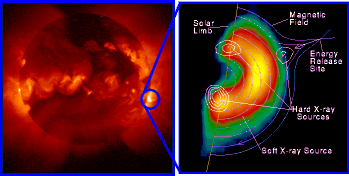|
|
|
Other RHESSI |
|
|
|
|
|
|
|
|
|
|
|
|
Hard X-Rays and Gamma-Rays
Photons from the hard X-ray and gamma-ray regions of the spectrum go right through optical elements and even the sides of an imaging device without being focused on a detector. This means that scientists can't form a picture by using ordinary optical imaging devices.
Scientists want to study violent eruptions on the Sun called solar flares and coronal mass ejections (CMEs). These events generally originate near sunspots that sometimes can be seen at optical wavelengths on the solar disk. They have been known to disrupt radio communications and even destroy the electronics in communications satellites. Some scientists are even trying to see if weather cycles on the Earth are related to the sunspot cycles. Solar flares and CME's release tremendous amounts of energy equivalent to a trillion tons of TNT, an energy release that is much greater than any other explosion in the modern solar system. Scientists feel that imaging flares in X-rays and gamma-rays will help them identify the mechanisms that produce the flares and ultimately help them predict solar weather.
Further information about High-Energy imaging may be found at The High-Energy Astrophysics Learning Center.
Solar flares tend to have hard X-ray hot spots that can tell us about mechanisms that produce the flare. X-rays are produced when electrons are deflected but not captured by a positively charged ion. High speed electrons in near collisions with positive ions produce the highest energy X-rays called bremsstrahlung radiation. Still higher energy photons called gamma-rays are created in solar events when energized nuclei go from an excited state back to a lower energy state. To study these highest energy emissions, scientists had to develop a different imaging technique.
![]()


